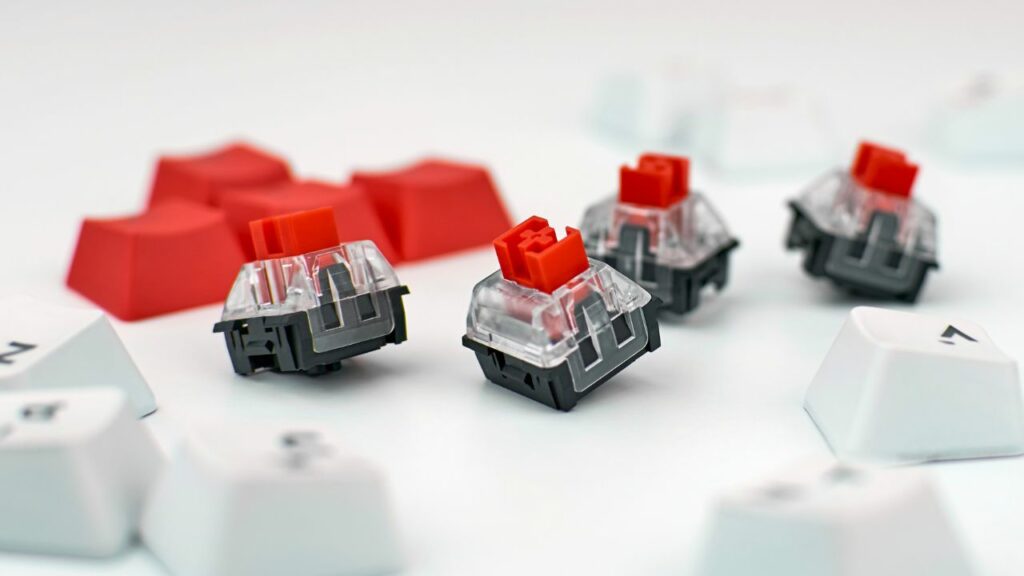
If you’ve been scouring the Internet trying to make sense of the multitude of choices for mechanical keyboard switches, you’re not alone. The great debate between linear and tactile switches often leaves typing enthusiasts and gamers alike in a state of confusion. But worry not! I’ve got you covered. Let’s plunge into the enigma of linear switches and their utility for typing.
The Basics: Linear vs. Tactile
Firstly, let’s understand what we’re dealing with. Linear switches, as the name suggests, offer a smooth keystroke from the top to the bottom with no tactile bump or click to notify of actuation. It’s akin to gliding down a hill on a sleek sled—swift and smooth. Meanwhile, tactile switches have a distinctive bump during the keystroke. It’s a bit like driving over a small speed bump, letting you know you’ve successfully input a key.
If we were to anthropomorphize them, linear switches would be the silent type, performing their tasks without much ado, while tactile switches would be the expressive ones, telling you how they’re doing every step of the way.
Why Choose Linear Switches?

The question that keeps many up at night is whether linear switches are good for typing. The answer, as with most things in life, is not a simple ‘yes’ or ‘no’. Linear switches are typically favored by gamers for their speed and quietness. For example, the Gateron Milky Yellow Pro and the Zaku Linears are renowned for their quick inputs and smooth keystrokes, making them a top pick among esports enthusiasts.
But what about typists? People who spend their day coding, writing, or any other keyboard-intensive task? Here’s the scoop: linear switches can be a fantastic choice if you value smoothness and a silent work environment. However, they do lack the tactile feedback, which some users find helpful for typing accuracy.
The Fine Art of Typing
While tactile switches, like the beloved Boba U4T or the Glorious Panda Switches, can offer that physical confirmation of a keystroke, some typists find this interruptive. For these folks, linear switches can be a breath of fresh air, offering a seamless typing experience.
Don’t be tricked into thinking that linear switches are solely built for speed. Some models do have shorter actuation or bottom-out distances, but this isn’t a linear exclusive feature. Remember, it depends on the specific switch model you choose, rather than the category of the switch.
Typing Speed and Accuracy: The Linear Switch Advantage
Let’s dive a bit deeper into the world of typing speed and accuracy. Remember when I mentioned that linear switches are popular among gamers for their speed? Well, they can also be a boon for typists, especially those touch typists who have mastered their craft and don’t rely on tactile feedback to confirm a keystroke.
The uninterrupted glide from top to bottom of a linear switch keypress allows for a continuous flow, which can boost typing speed. Imagine yourself at a piano recital, your fingers dancing over the keys in a seamless waltz—that’s the rhythm linear switches can offer to touch typists. However, with great speed comes great responsibility. Linear switches might require more conscious finger control to prevent accidental key presses, given the lack of that bump to alert you of actuation.
If you’re interested in exploring this further, I recommend checking out this comprehensive guide on the best linear switches to find a linear switch that fits your typing style.
Ergonomics and Fatigue: Lightening the Load with Linear Switches

Typing is often a marathon, especially for those of us who spend endless hours tapping our keyboards. This is where the importance of ergonomics and the idea of typing fatigue surfaces. If you’ve ever found your fingers, hands, or wrists throbbing after an intense day of typing, you’ll resonate with the significance of a keyboard that meshes with your natural typing mechanics.
Linear switches, with their smooth and consistent actuation, can provide a more relaxed typing experience. The unobstructed motion requires less force, which in turn reduces the strain on your digits, leading to a potentially more ergonomic typing session.
However, the lack of tactile feedback means typists might have to maintain a lighter touch to prevent bottoming out—that is, pressing the key all the way down with more force than necessary. Excessive bottoming out can lead to potential fatigue, but don’t let this deter you. It’s a bit like learning to ride a bike; it might feel wobbly at first, but over time, your fingers will learn to glide over the keys with just the right amount of pressure.
In conclusion, linear switches can offer a typing experience that’s both swift and gentle, provided you adapt your typing style accordingly. They may not be the best fit for everyone, but for those who embrace them, they could be a game-changer. Remember, typing is an art, and finding the right tools can make the process a joy, rather than a chore.
Personalizing Your Typing Experience
There’s no one-size-fits-all in the world of mechanical keyboard switches. The best advice I can give you? Try before you buy. Consider investing in a switch tester or a hot swappable keyboard to test out both linear and tactile switches. It’s like going on a few dates before committing—it saves both your heart and your wallet from potential disappointment. Who knows, maybe you’re into heavy linear switches or perhaps your someone more into those thocky linear switches.
Finally, let’s not forget that typing on a new switch type might feel alien at first. It’s like moving into a new house—everything feels a bit off initially, but give it some time and it will start to feel like home.
Conclusion: Linear Switches for Typing? Yes, But It Depends
In a nutshell, linear switches can offer a typing experience that’s quick and gentle, assuming you modify your typing style accordingly. They might not be the perfect fit for everyone, but for those who can adapt, they might just be a game-changer. Always remember, typing is an art, and finding the right tools can transform the process from a chore to a delight.